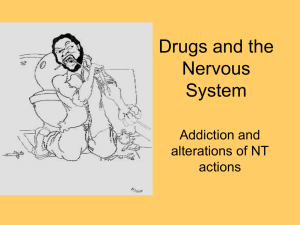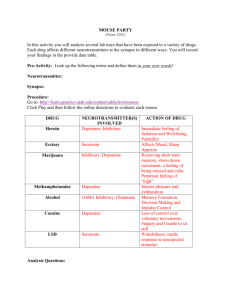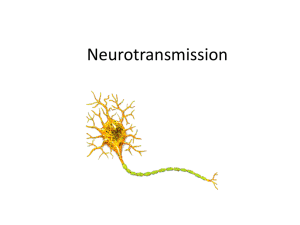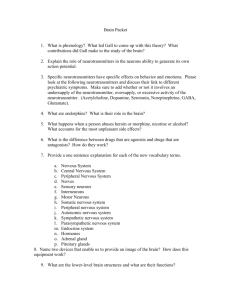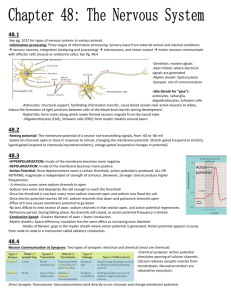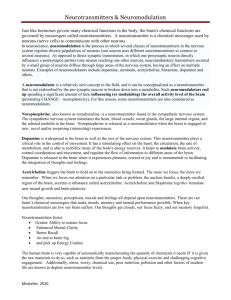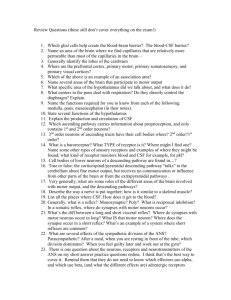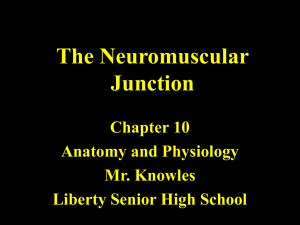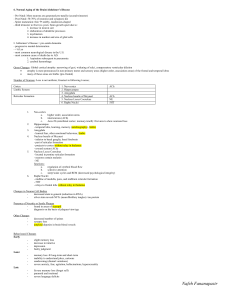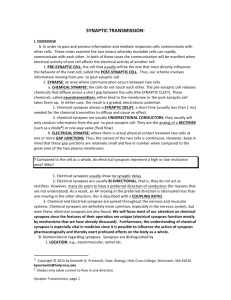Chapter 2
advertisement
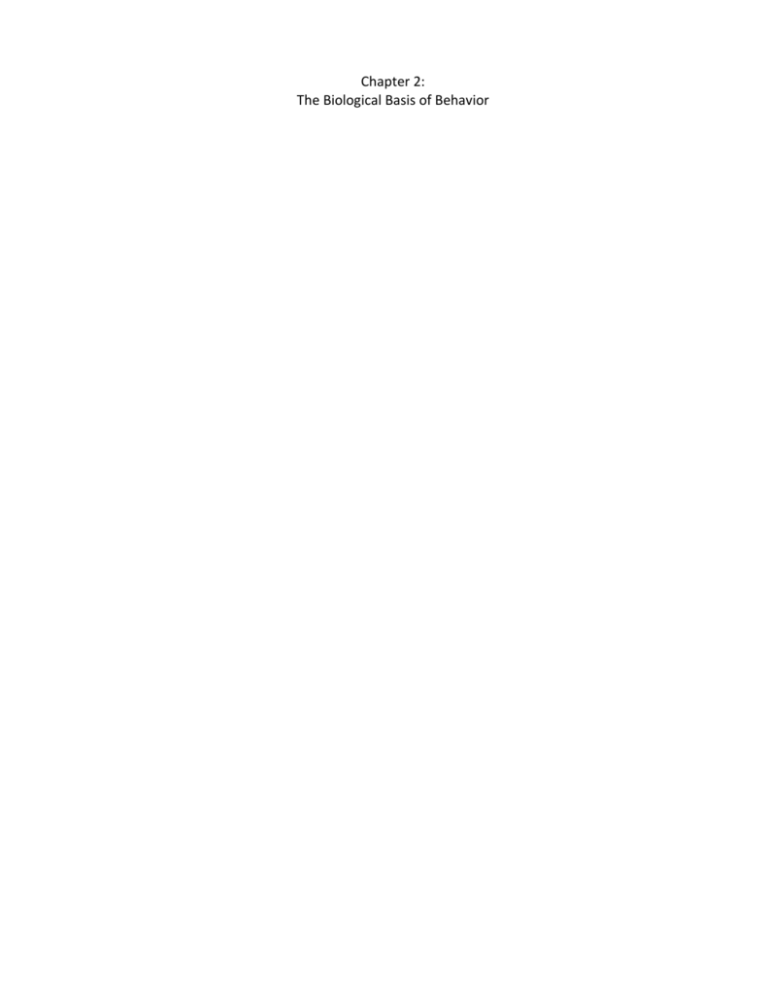
Chapter 2: The Biological Basis of Behavior I. Neurons: The Messengers A. Overview and general structural organization of nervous system (Fig. 2-2) B. Structure of Neuron 1. General 2. Dendrites 3. Cell body 4. Axon 5. Myelin sheath 6. A Nerve or Tract is a group of axons bundled together. C. Kinds of Neurons: 1. Sensory (afferent; inward) 2. Motor (efferent; outward) 3. Interneurons (association; between afferent and efferent) Note: also Glial cells (glia; “housekeeping”) that don’t transmit impulses) D. The Neural Impulse: Transmission within a neuron 1. Polarization and Resting Potential 2. Action Potential a. Ions and Action Potential b. Threshold of Excitation c. Refractory Period d. Speed of Neural Impulse: depends, around 300 mph in some cases e. All-or-None Law f. Excitation and inhibition E. The Synapse: Transmission between neurons 1. The Synapse 2. The Pre-synaptic Anatomy and Activities a. Terminal Button or Synaptic Knob b. Synaptic Vesicles c. Neurotransmitters d. Synaptic Cleft or Synaptic Space 3. The Post-Synaptic Anatomy and Activities a. Receptor Sites b. Reuptake 4. Neurotransmitters a. Acetylcholine b. Dopamine c. Serotonin d. Norepinephrine e. Endorphins F. Synaptic mechanisms 1. Action potential on pre-synaptic membrane causes 2. NT release from vesicles, and then 3. NT flows across synapse, and then 4. NT strikes receptor site, causing depolarization and initiating action potential on postsynaptic membrane, and then 5. Enzyme degrades NT, and then 6. Re-uptake of NT, and then 7. Synthesis into vesicles of pre-synaptic membrane ∙ ∙ ∙ ∙ ∙ ∙ ∙ ∙ ∙ ∙ ∙ ∙ G. Interference with synaptic mechanisms botulism: prevents release of ACh reserpine: causes NT to leak from vesicles black widow spider venom: releases Ach caffeine: blocks action of chemical that ordinarily inhibits release of excitatory NT LSD: attaches to receptor site for serotonin, blocking normal inhibitory action of this NT atropine: blocks receptor site for ACh in brain curare: blocks receptor sites for ACh in skeletal system cocaine: prevents reuptake of dopamine schizophrenia: excess of dopamine; medication blocks dopamine receptors depression: reduced serotonin; Prozac blocks re-uptake of serotonin nerve gases, pesticides: destroy enzyme that ordinarily degrades ACh nicotine: stimulates ACh receptors in brain H. Experience and Neurons 1. Experience can change the structure in an animal’s brain -- “neural plasticity” (Rosenzweig, 1996). 2. LTP (long term potentiation) II. Central Nervous System A. Brain 1. Hindbrain (central core) a. medulla - controls breathing, heart rate, and blood pressure. b. pons -- connects the cerebral cortex at the top of the brain to the cerebellum. c. cerebellum -- controls certain reflexes, coordinates body movement, and maintains equilibrium. 2. Midbrain (limbic system): The region between hindbrain and forebrain which is important for hearing and sight and is one of the primary places in the brain where pain is registered. Important structures are hippocampus and amygdala. 3. Forebrain a. Thalamus b. Hypothalamus c. Cerebrum/Cerebral hemispheres d. Cerebral Cortex B. Cortical areas and their functions 1. Occipital: visual information 2. Temporal: auditory information 3. Parietal: somato-sensory 4. Frontal: voluntary motor movement C. Hemispheric specialization 1. Corpus callosum 2. Left Hemisphere 3. Right Hemisphere 4. "Split-brain" psychosurgery 5. Language: Broca’s area, Wernicke’s area 6. Handedness D. Reticular formation: wakefulness, alertness, arousal. Spread across hindbrain, midbrain, and into forebrain. E. Limbic system 1. Memory and emotions 2. Primary structures: a. Hippocampus b. Amygdala F. Spinal cord 1. Structure 2. Spinal reflexes III. Peripheral Nervous System A. Somatic nervous system Skeletal (striped) muscles B. Autonomic nervous system 1. Smooth muscles 2. Sympathetic branch: a. Prepares for emergency or arousal. b. Fight or Flight 3. Parasympathetic branch: a. Calms, relaxes body, returns to normal; involved in digestion and processes which conserve and protect bodily functions. b. Relaxation work, especially bio-feedback. IV. Endocrine System A. Function 1. Release hormones from ductless glands into bloodstream 2. Organize nervous system and body tissues 3. Activate behavior B. Thyroid 1. Regulates metabolism 2. Affects activity level and emotional state. C. Parathyroids D. Pineal gland: Day-night activity levels E. Pancreas 1. Insulin/glucagon 2. Blood sugar regulation F. Pituitary 1. Posterior a. Vasopressin b. Oxytocin 2. Anterior: "master gland"; a. Linked also to nervous system and hormones released by hypothalamus b. Produces growth hormone c. Releases ACTH (stress hormone) and can affect the adrenal glands G. Gonads 1. Males: androgens (testosterone) 2. Females: estrogens (progesterone) 3. Sexual/reproductive function. Studies suggest that they have some other effects, e.g., effects on aggression and on learning H. Adrenal Glands V. Behavior Genetics and Our Human Heritage A. Genetics 1. Basic Facts 2. Chromosomes and Genes a. Genes b. Chromosomes c. DNA d. Dominant and recessive genes e. Sex-linked genes (M > F) (1) color blindness (2) hemophilia f. Blueprints or recipes? B. Genetics and Behavior 1. Animal Behavior Genetics: a. Heritability of behavioral traits b. Selective breeding: Thompson (1954) 2. Human Behavior Genetics: a. Human Genome Project: Map all 23 pairs of human chromosomes. b. Twin, adoption, and family studies C. Natural selection: How evolution occurs and which traits survive. D. Environment-Genetic Interaction: 1. Genes predispose to environmental influence, environment supplies influence to actually produce behavioral effect 2. Examples: Diabetes <=> overweight Schizophrenia <=> stress Neurotransmitters Over 50 different kinds. Fragments of other organic molecules can simulate neurotransmitters. Some neurotransmitters have multiple functions (excitatory, inhibitory). Antagonists block or inhibit the normal process. Agonists facilitate it. Acetylcholine (ACh). Usually excitatory. Attention, arousal, motivation, memory, skeletal muscle movement. Skeletal muscles and hippocampus. In muscles, botulism toxin prevents release of Acetylcholine (Ach). Curare and cobra venom block receptor sites. Venom of black widow spider and certain nerve gases have a destroy Enzyme (AchE) that degrades Ach, allowing it to flood the synapse and prolong its action, causing convulsions. Possible link to Alzheimer's via reduced production of Ach in brain cells. Dopamine. Generally inhibitory. Wide range of behavior and emotions. Excess = schizophrenia; shortage = Parkinson's disease. Chlorpromazine, a tranquilizer, blocks receptor sites in brain. Cocaine also inhibits reuptake of dopamine. This was the neurotransmitter focused on in the book/movie Awakenings, especially its chemical precursor L-Dopa. Serotonin. Generally inhibitory. Most activities, sleep onset, mood, eating. LSD has similar structure and activates neurons in the brain that are normally inhibited by that neurotransmitter. Medications for depression and anxiety such as Prozac, Paxil, Zoloft, and Luvox are all Selective Serotonin Reuptake Inhibitors (SSRI). Norepinephrine (NE). Generally excitatory. Arousal, wakefulness, learning, memory, mood. Neurons in brain stem. Amphetamines, cocaine slow down reuptake and prolong action, lithium speeds up the reuptake. Gamma-aminobutyric acid (GABA): Inhibitory. Glutamate. Involved in long term potentiation. Endorphins: (name composed of endogenous morphine: natural opiate-like neurotransmitter--or often referred to as neuromodulator-- which is linked to pain control and pleasure.
